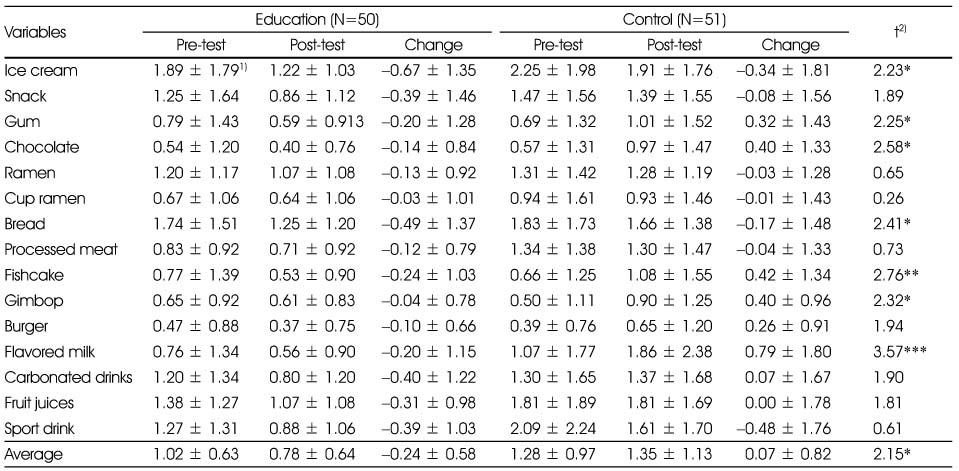References
1. Bateman B, Warner JO, Hutchinson E, Dean T, Rowlandson P, Gant C, Grundy J, Fitzgerald C, Stevenson J. The effects of a double blind, placebo controlled, artificial food colourings and benzoate preservative challenge on hyperactivity in a general population sample of preschool children. Arch Dis Child 2004. 89(6)506–511.
2. Chang SO, Lee OH, Lee KS. Intake of processed foods and the effects of nutrition label education in 5th grade children. J Korean Diet Assoc 2008. 14(2)166–175.
3. Choi JY, Ryu SH. Effect of the dietary life education program on elementary school students nutrition knowledge and eating habit. J Korean Pract Arts Educ 2010. 23(2)319–334.
4. Evers CL. How to teach nutrition to kids 2003. the 3rd editionth ed. 24 Carrots Press: Portland, pp; 31–40.
5. Jung SA, Lee KA. Effects of a nutrition education program using children's books on elementary school students' food preferences and eating behavior. J Korean Soc Food Sci Nutr 2007. 36(9)1161–1171.
6. Jung YY, Shin EK, Lee HJ, Lee NH, Chun BY, Ahn MY, Lee YK. Development and evaluation of a nutrition education program on sodium reduction in elementary school students. Korean J Community Nutr 2009. 14(6)746–755.
7. Kajanne A, Pirttil-Backman AM. Toward an understanding of laypeople's notions about additives in food: clear-cut viewpoints about additives decrease with education. Appetite 1996. 27(3)207–222.
8. Kang DY. A study on the buying behavior of processed foods and their understanding of food additives in middle school students of Jeju province 2008. Jeju National University; 65–71.
MS thesis.
9. Kang SA, Lee JW, Kim KE, Koo JO, Park DY. A study of the frequency of food purchase for snacking and its related ecological factors on elementary school children. Korean J Community Nutr 2004. 9(4)453–463.
10. Kim HJ, Jung KA. A study on the development and the effect of dietary life education program about 'processed foods' for elementary school students. J Korean Pract Arts Educ 2010. 23(2)267–294.
11. Kim JH, Yum YN, Ko YK, Lee WS, Kim JE, Park SN. Toxicological evaluation study on combinational intake of food additives. Annu Rep Korea Food Drug Adm 2008. 12329–373.
12. Kim SB, Choi HJ. Effects of nutrition education using food exchange system: changes in elementary students' nutrition knowledge, dietary attitude and nutrients intake. Korean J Community Nutr 2008. 13(6)922–933.
13. Kim SM, Kim JW. Development of risk communication strategy and educational homepage on food additives. Korean J Community Nutr 2010. 15(2)240–252.
14. Koo JO, Kim KW, Kim CI, Park DY, Park HR, Yoon EY. Nutrition education and practice 2007. Seoul: Power Book; 114–118.
18. Kwon DH, Han SN, Kim HK. Evaluation of a nutrition education program for 3rd grade elementary school students. Korean J Community Nutr 2011. 16(2)183–194.
19. Lee KW, Lee HS, Lee MJ. A study on the eating behaviors of self-purchasing snack among elementary school students. Korean J Food Cult 2005. 20(5)594–602.
20. Lee YM, Park HN. The effectiveness of Na education program in elementary school - six month follow-up study -. Korean J Community Nutr 2010. 15(5)603–613.
21. Min JE. A study on purchase behaviors of processed food and recognitions of food additives for elementary school students and their parents 2009. Hanyang University; 51–60.
MS thesis.
22. Ministry of Health and Welfare. Korea Health Industry Development Institute. The third Korean National Health & Nutrition Examination Survey (KNHANES III), 2005 - Nutrition Survey (I) 2006. 298–299.
23. McCann D, Barrett A, Cooper A, Crumpler D, Dalen L, Grimshaw K, Kitchin E, Lok K, Porteous L, Prince E, Sonuga-Barke E, Warner JO, Stevenson J. Food additives and hyperactive behavior in 3-year-old and 8/9-year-old children in the community: a randomized, double-blinded, placebo-controlled trial. Lancet 2007. 370(9598)1560–1567.
24. Park HJ, Lee JS, Kim EK. Assessment of nutrition label education in sixth grade elementary school students. J Korean Diet Assoc 2010. 16(3)226–238.
25. Park M, Park HR, Kim SJ, Kim MS, Kong KH, Kim HS, Gong EJ, Kim ME, Kim HS, Lee BM, Lee J. Risk assessment for the combinational effects of food color additives neural progenitor cells and hippocampal neurogenesis. J Toxicol Environ Health A 2009. 72(21-22)1412–1423.
26. Park SK, Lee TS, Park SK. Estimation of daily dietary intake of food red colors - food red No. 2, No. 3 and No. 40 -. J Korean Soc Food Sci Nutr 2005. 34(1)75–80.
27. Seo YS, Chung YJ. The effect of nutrition education on the improvement of psychosocial factors related to vegetable and fruit intake of elementary school children in pre-action stages. Korean J Nutr 2010. 43(6)597–606.
28. World Health Organization. Food and Agriculture Organization of the United Nations. Evaluation of certain food additives. Seventy-first report of the joint FAO/WHO Expert Committee on Food Additives. World Health Organ Tech Rep Ser 2010. (956)1–80.
29. Williamson CS. Food additives and hyperactivity in children. Nutr Bulletin 2008. 33(1)4–7.






